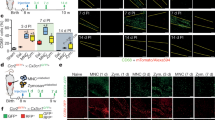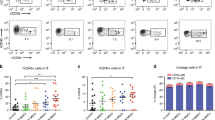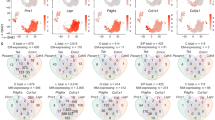Abstract
Under conditions of tissue injury, myocardial replication and regeneration have been reported1. A growing number of investigators have implicated adult bone marrow (BM) in this process, suggesting that marrow serves as a reservoir for cardiac precursor cells2,3,4,5,6. It remains unclear which BM cell(s) can contribute to myocardium, and whether they do so by transdifferentiation or cell fusion. Here, we studied the ability of c-kit-enriched BM cells, Lin- c-kit+ BM cells and c-kit+ Thy1.1lo Lin- Sca-1+ long-term reconstituting haematopoietic stem cells to regenerate myocardium in an infarct model. Cells were isolated from transgenic mice expressing green fluorescent protein (GFP) and injected directly into ischaemic myocardium of wild-type mice. Abundant GFP+ cells were detected in the myocardium after 10 days, but by 30 days, few cells were detectable. These GFP+ cells did not express cardiac tissue-specific markers, but rather, most of them expressed the haematopoietic marker CD45 and myeloid marker Gr-1. We also studied the role of circulating cells in the repair of ischaemic myocardium using GFP+–GFP- parabiotic mice. Again, we found no evidence of myocardial regeneration from blood-borne partner-derived cells. Our data suggest that even in the microenvironment of the injured heart, c-kit-enriched BM cells, Lin- c-kit+ BM cells and c-kit+ Thy1.1lo Lin- Sca-1+ long-term reconstituting haematopoietic stem cells adopt only traditional haematopoietic fates.
This is a preview of subscription content, access via your institution
Access options
Subscribe to this journal
Receive 51 print issues and online access
$199.00 per year
only $3.90 per issue
Buy this article
- Purchase on Springer Link
- Instant access to full article PDF
Prices may be subject to local taxes which are calculated during checkout




Similar content being viewed by others
References
Beltrami, A. P. et al. Evidence that human cardiac myocytes divide after myocardial infarction. N. Engl. J. Med. 344, 1750–1757 (2001)
Quaini, F. et al. Chimerism of the transplanted heart. N. Engl. J. Med. 346, 5–15 (2002)
Jackson, K. A. et al. Regeneration of ischemic cardiac muscle and vascular endothelium by adult stem cells. J. Clin. Invest. 107, 1395–1402 (2001)
Toma, C., Pittenger, M. F., Cahill, K. S., Byrne, B. J. & Kessler, P. D. Human mesenchymal stem cells differentiate to a cardiomyocyte phenotype in the adult murine heart. Circulation 105, 93–98 (2002)
Deb, A. et al. Bone marrow-derived cardiomyocytes are present in adult human heart: a study of gender-mismatched bone marrow transplantation patients. Circulation 107, 1247–1249 (2003)
Orlic, D. et al. Mobilized bone marrow cells repair the infarcted heart, improving function and survival. Proc. Natl Acad. Sci. USA 98, 10344–10349 (2001)
Orlic, D. et al. Bone marrow cells regenerate infarcted myocardium. Nature 410, 701–705 (2001)
Wagers, A. J., Sherwood, R. I., Christensen, J. L. & Weissman, I. L. Little evidence for developmental plasticity of adult hematopoietic stem cells. Science 297, 2256–2259 (2002)
Wright, D. E., Wagers, A. J., Gulati, A. P., Johnson, F. L. & Weissman, I. L. Physiological migration of hematopoietic stem and progenitor cells. Science 294, 1933–1936 (2001)
Terada, N. et al. Bone marrow cells adopt the phenotype of other cells by spontaneous cell fusion. Nature 416, 542–545 (2002)
Ying, Q. L., Nichols, J., Evans, E. P. & Smith, A. G. Changing potency by spontaneous fusion. Nature 416, 545–548 (2002)
Alvarez-Dolado, M. et al. Fusion of bone-marrow-derived cells with Purkinje neurons, cardiomyocytes and hepatocytes. Nature 425, 968–973 (2003)
Oh, H. et al. Cardiac progenitor cells from adult myocardium: homing, differentiation, and fusion after infarction. Proc. Natl Acad. Sci. USA 100, 12313–12318 (2003)
Laflamme, M. A., Myerson, D., Saffitz, J. E. & Murry, C. E. Evidence for cardiomyocyte repopulation by extracardiac progenitors in transplanted human hearts. Circ. Res. 90, 634–640 (2002)
Tse, H. F. et al. Angiogenesis in ischaemic myocardium by intramyocardial autologous bone marrow mononuclear cell implantation. Lancet 361, 47–49 (2003)
Stamm, C. et al. Autologous bone-marrow stem-cell transplantation for myocardial regeneration. Lancet 361, 45–46 (2003)
Wright, D. E. et al. Cyclophosphamide/granulocyte colony-stimulating factor causes selective mobilization of bone marrow hematopoietic stem cells into the blood after M phase of the cell cycle. Blood 97, 2278–2285 (2001)
Acknowledgements
We thank G. Hoyt for technical assistance with animal surgery, and V. Mariano and L. Hildalgo for animal care. This work was supported by the Falk Cardiovascular research fund (R.C.R.) and an NIH grant (I.L.W.). L.B.B. was supported by Thoracic Surgery Foundation Nina Starr Braunwald Research Training Fellowship; A.J.W. was supported by an American Cancer Society grant and the Frederick Frank/Lehman Brothers, Inc. Irvington Institute Fellowship; J.L.C. was supported by a NIH Training Grant in Molecular and Cellular Immunobiology; and T.K. was supported by a German Research Society Training Grant.
Author information
Authors and Affiliations
Corresponding author
Ethics declarations
Competing interests
Affiliations that might be perceived to have biased this work are as follows: (1) I.L.W. owns significant Amgen stock from participation on their scientific advisory board; (2) I.L.W. co-founded and consulted for Systemix, is a co-founder and director of Stem Cells, Inc., and recently co-founded Cellerant. None of these is involved in cardiac regeneration or the identification of bone marrow myocardial precursor cells.
Supplementary information
Supplementary Figure 1
Cardiac tissue stained with Masson’s trichrome stain at 10 days and 30 days after infarction (JPG 71 kb)
Supplementary Figure 2
Lymphoid differentiation of LT-HSCs injected into ischemic myocardium. (JPG 20 kb)
Supplementary Figure 3
Cardiac tissue stained with Masson’s trichrome stain 6 weeks after infarction. (JPG 71 kb)
Supplementary Tables
Table 1: Echocardiographic function of cell-treated vs. saline-treated infarcted hearts at 2 weeks and 6 weeks post-injury; Table 2: Hemodynamic parameters of cell-treated and saline-treated infarcted animals 6 weeks after infarction; Table 3: Hematopoietic chimerism in parabiotic pairs. (DOC 38 kb)
Rights and permissions
About this article
Cite this article
Balsam, L., Wagers, A., Christensen, J. et al. Haematopoietic stem cells adopt mature haematopoietic fates in ischaemic myocardium. Nature 428, 668–673 (2004). https://doi.org/10.1038/nature02460
Received:
Accepted:
Published:
Issue Date:
DOI: https://doi.org/10.1038/nature02460
This article is cited by
-
Safety and outcomes analysis: transcatheter implantation of autologous angiogenic cell precursors for the treatment of cardiomyopathy
Stem Cell Research & Therapy (2023)
-
HSF-1 enhances cardioprotective potential of stem cells via exosome biogenesis and their miRNA cargo enrichment
Stem Cell Reviews and Reports (2023)
-
TSG-6 released from adipose stem cells-derived small extracellular vesicle protects against spinal cord ischemia reperfusion injury by inhibiting endoplasmic reticulum stress
Stem Cell Research & Therapy (2022)
-
Lnc Tmem235 promotes repair of early steroid-induced osteonecrosis of the femoral head by inhibiting hypoxia-induced apoptosis of BMSCs
Experimental & Molecular Medicine (2022)
-
Mesenchymal stem cell-derived exosomes: therapeutic opportunities and challenges for spinal cord injury
Stem Cell Research & Therapy (2021)
Comments
By submitting a comment you agree to abide by our Terms and Community Guidelines. If you find something abusive or that does not comply with our terms or guidelines please flag it as inappropriate.



